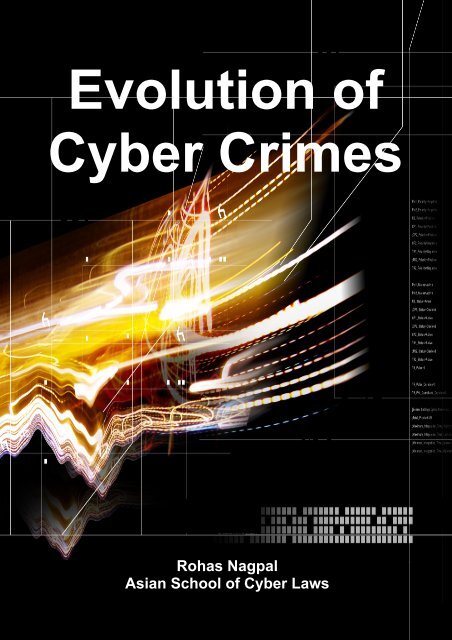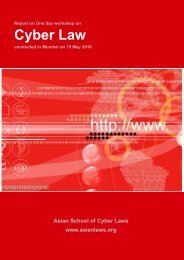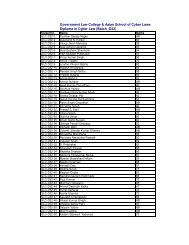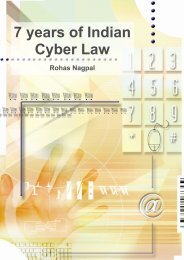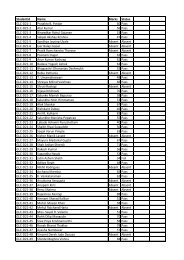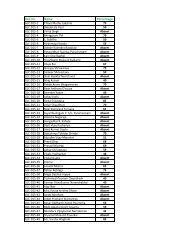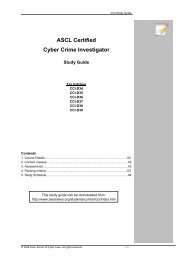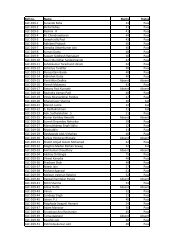Rohas Nagpal Asian School of Cyber Laws - Department of ...
Rohas Nagpal Asian School of Cyber Laws - Department of ...
Rohas Nagpal Asian School of Cyber Laws - Department of ...
Create successful ePaper yourself
Turn your PDF publications into a flip-book with our unique Google optimized e-Paper software.
Evolution <strong>of</strong><br />
<strong>Cyber</strong> Crimes<br />
<strong>Rohas</strong> <strong>Nagpal</strong><br />
<strong>Asian</strong> <strong>School</strong> <strong>of</strong> <strong>Cyber</strong> <strong>Laws</strong>
About the author<br />
<strong>Rohas</strong> <strong>Nagpal</strong> is the founder President <strong>of</strong> <strong>Asian</strong> <strong>School</strong> <strong>of</strong><br />
<strong>Cyber</strong> <strong>Laws</strong>.<br />
He advises Governments and corporates around the world<br />
in cyber crime investigation and cyber law related issues.<br />
He has assisted the Government <strong>of</strong> India in drafting rules<br />
and regulations under the Information Technology Act,<br />
2000.<br />
He has authored several books, papers and articles on<br />
cyber law, cyber terrorism, cyber crime investigation and<br />
financial law.<br />
<strong>Rohas</strong> lives in Pune (India) and blogs @ rohasnagpal.com<br />
Some <strong>of</strong> the papers authored by <strong>Rohas</strong> <strong>Nagpal</strong><br />
1. Internet Time Theft & the Indian Law<br />
2. Legislative Approach to Digital Signatures<br />
3. Indian Legal position on <strong>Cyber</strong> Terrorism<br />
4. Defining <strong>Cyber</strong> Terrorism<br />
5. The mathematics <strong>of</strong> terror<br />
6. <strong>Cyber</strong> Terrorism in the context <strong>of</strong> Globalisation<br />
7. Biometric based Digital Signature Scheme<br />
Some <strong>of</strong> the books authored by <strong>Rohas</strong> <strong>Nagpal</strong>
<strong>Asian</strong> <strong>School</strong> <strong>of</strong> <strong>Cyber</strong> <strong>Laws</strong><br />
1. EVOLUTION OF CYBER CRIME ........................................................................... 2<br />
1.1 FINANCIAL CRIMES................................................................................................ 3<br />
1.2 CYBER PORNOGRAPHY......................................................................................... 5<br />
1.3 SALE OF ILLEGAL ARTICLES................................................................................. 6<br />
1.4 ONLINE GAMBLING................................................................................................ 7<br />
1.5 INTELLECTUAL PROPERTY CRIMES ...................................................................... 8<br />
1.6 EMAIL SPOOFING................................................................................................... 9<br />
1.7 FORGERY ............................................................................................................. 10<br />
1.8 CYBER DEFAMATION........................................................................................... 11<br />
1.9 CYBER STALKING................................................................................................ 12<br />
1.10 WEB DEFACEMENT............................................................................................ 14<br />
1.11 EMAIL BOMBING................................................................................................ 16<br />
1.12 DATA DIDDLING................................................................................................. 17<br />
1.13 SALAMI ATTACKS.............................................................................................. 18<br />
1.14 DENIAL OF SERVICE ATTACK ........................................................................... 20<br />
1.15 VIRUS / WORM ATTACKS .................................................................................. 21<br />
1.16 TROJANS AND KEYLOGGERS............................................................................ 24<br />
1.17 INTERNET TIME THEFT ...................................................................................... 25<br />
1.18 WEB JACKING ................................................................................................... 26<br />
1.19 EMAIL FRAUDS.................................................................................................. 29<br />
1.20 CYBER TERRORISM........................................................................................... 32<br />
1.21 USE OF ENCRYPTION BY TERRORISTS .............................................................. 36<br />
© 2008 <strong>Rohas</strong> <strong>Nagpal</strong>. All rights reserved. - 1 -
<strong>Asian</strong> <strong>School</strong> <strong>of</strong> <strong>Cyber</strong> <strong>Laws</strong><br />
1. Evolution <strong>of</strong> cyber crime<br />
The first recorded cyber crime took place in the year 1820!<br />
That is not surprising considering the fact that the abacus, which is<br />
thought to be the earliest form <strong>of</strong> a computer, has been around since<br />
3500 B.C. in India, Japan and China. The era <strong>of</strong> modern computers,<br />
however, began with the analytical engine <strong>of</strong> Charles Babbage.<br />
In 1820, Joseph-Marie Jacquard, a textile manufacturer in France,<br />
produced the loom. This device allowed the repetition <strong>of</strong> a series <strong>of</strong> steps<br />
in the weaving <strong>of</strong> special fabrics. This resulted in a fear amongst<br />
Jacquard's employees that their traditional employment and livelihood<br />
were being threatened. They committed acts <strong>of</strong> sabotage to discourage<br />
Jacquard from further use <strong>of</strong> the new technology. This is the first<br />
recorded cyber crime!<br />
Today, computers have come a long way with neural networks and nanocomputing<br />
promising to turn every atom in a glass <strong>of</strong> water into a<br />
computer capable <strong>of</strong> performing a billion operations per second.<br />
In a day and age when everything from microwave ovens and<br />
refrigerators to nuclear power plants are being run on computers, cyber<br />
crime has assumed rather sinister implications.<br />
<strong>Cyber</strong> crime can involve criminal activities that are traditional in nature,<br />
such as theft, fraud, forgery, defamation and mischief. The abuse <strong>of</strong><br />
computers has also given birth to a gamut <strong>of</strong> new age crimes such as<br />
hacking, web defacement, cyber stalking, web jacking etc.<br />
A simple yet sturdy definition <strong>of</strong> cyber crime would be “unlawful acts<br />
wherein the computer is either a tool or a target or both”.<br />
The term computer used in this<br />
definition does not only mean the<br />
conventional desktop or laptop<br />
computer. It includes Personal<br />
Digital Assistants (PDA), cell<br />
phones, sophisticated watches, cars<br />
and a host <strong>of</strong> gadgets.<br />
Recent global cyber crime incidents like the targeted denial <strong>of</strong> service<br />
attacks on Estonia have heightened fears. Intelligence agencies are<br />
preparing against coordinated cyber attacks that could disrupt rail and air<br />
traffic controls, electricity distribution networks, stock markets, banking<br />
and insurance systems etc.<br />
Unfortunately, it is not possible to calculate the true social and financial<br />
impact <strong>of</strong> cyber crime. This is because most crimes go unreported.<br />
- 2 - © 2008 <strong>Rohas</strong> <strong>Nagpal</strong>. All rights reserved.
<strong>Asian</strong> <strong>School</strong> <strong>of</strong> <strong>Cyber</strong> <strong>Laws</strong><br />
1.1 Financial Crimes<br />
Money is the most common motive behind all crime. The same is also<br />
true for cyber crime. Globally it is being observed that more and more<br />
cyber crimes are being committed for financial motives rather than for<br />
“revenge” or for “fun”.<br />
With the tremendous increase in the use <strong>of</strong> internet and mobile banking,<br />
online share trading, dematerialization <strong>of</strong> shares and securities, this trend<br />
is likely to increase unabated.<br />
Financial crimes include cyber cheating, credit card frauds, money<br />
laundering, hacking into bank servers, computer manipulation,<br />
accounting scams etc.<br />
Illustration 1<br />
Punjab National Bank in India was<br />
cheated to the tune <strong>of</strong> Rs. 13.9<br />
million through false debits and<br />
credits in computerized accounts.<br />
Illustration 2<br />
Rs. 2,50,000 were misappropriated<br />
from Bank <strong>of</strong> Baroda in India<br />
through falsification <strong>of</strong> computerized<br />
bank accounts.<br />
Illustration 3<br />
The Hyderabad police in India<br />
arrested an unemployed computer<br />
operator and his friend, a steward in<br />
a prominent five-star hotel, for<br />
stealing and misusing credit card<br />
numbers belonging to hotel<br />
customers.<br />
The steward noted down the<br />
various details <strong>of</strong> the credit cards,<br />
which were handed by clients <strong>of</strong> the<br />
hotel for paying their bills. Then, he<br />
passed all the details to his<br />
computer operator friend who used<br />
the details to make online<br />
purchases on various websites.<br />
Illustration 4<br />
In 2004, the US Secret Service<br />
investigated and shut down an<br />
online organization that trafficked in<br />
around 1.7 million stolen credit<br />
cards and stolen identity information<br />
and documents.<br />
© 2008 <strong>Rohas</strong> <strong>Nagpal</strong>. All rights reserved. - 3 -
<strong>Asian</strong> <strong>School</strong> <strong>of</strong> <strong>Cyber</strong> <strong>Laws</strong><br />
This high-pr<strong>of</strong>ile case, known as<br />
“Operation Firewall,” focused on a<br />
criminal organization <strong>of</strong> some 4,000<br />
members whose Web site<br />
functioned as a hub for identity theft<br />
activity.<br />
Illustration 5<br />
In 2003, a hacker was convicted in<br />
the USA for causing losses <strong>of</strong><br />
almost $25 million. The defendant<br />
pleaded guilty to numerous charges<br />
<strong>of</strong> conspiracy, computer intrusion,<br />
computer fraud, credit card fraud,<br />
wire fraud, and extortion.<br />
The hacker and his accomplices<br />
from Russia had stolen usernames,<br />
passwords, credit card information,<br />
and other financial data by hacking<br />
into computers <strong>of</strong> US citizens. They<br />
would then extort money from those<br />
victims with the threat <strong>of</strong> deleting<br />
their data and destroying their<br />
computer systems.<br />
- 4 - © 2008 <strong>Rohas</strong> <strong>Nagpal</strong>. All rights reserved.
<strong>Asian</strong> <strong>School</strong> <strong>of</strong> <strong>Cyber</strong> <strong>Laws</strong><br />
1.2 <strong>Cyber</strong> Pornography<br />
<strong>Cyber</strong> pornography is believed to be one <strong>of</strong> the largest businesses on the<br />
Internet today. The millions <strong>of</strong> pornographic websites that flourish on the<br />
Internet are testimony to this. While pornography per se is not illegal in<br />
many countries, child pornography is strictly illegal in most nations today.<br />
<strong>Cyber</strong> pornography covers pornographic websites, pornographic<br />
magazines produced using computers (to publish and print the material)<br />
and the Internet (to download and transmit pornographic pictures,<br />
photos, writings etc).<br />
Illustration 1<br />
A school student from Delhi (India),<br />
who was regularly teased for having<br />
a pockmarked face, used a free<br />
hosting provider to create<br />
www.amazing-gents.8m.net.<br />
He regularly uploaded “morphed”<br />
photographs <strong>of</strong> teachers and girls<br />
from his school onto the website.<br />
He was arrested when the father <strong>of</strong><br />
one <strong>of</strong> the victims reported the case<br />
to the police.<br />
Illustration 2<br />
The CEO <strong>of</strong> online auction website<br />
bazee.com (a part <strong>of</strong> the ebay<br />
group) was arrested by the Delhi<br />
police for violating India’s strict laws<br />
on cyber pornography. An<br />
engineering student was using the<br />
bazee website to sell a video<br />
depicting two school students<br />
having sexual intercourse.<br />
Bazee.com was held liable for<br />
distributing porn and hence the<br />
CEO was arrested.<br />
Illustration 3<br />
The CEO <strong>of</strong> a s<strong>of</strong>tware company in<br />
Pune (India) was arrested for<br />
sending highly obscene emails to a<br />
former employee.<br />
© 2008 <strong>Rohas</strong> <strong>Nagpal</strong>. All rights reserved. - 5 -
<strong>Asian</strong> <strong>School</strong> <strong>of</strong> <strong>Cyber</strong> <strong>Laws</strong><br />
1.3 Sale <strong>of</strong> Illegal Articles<br />
It is becoming increasingly common to find cases where sale <strong>of</strong> illegal<br />
articles such as narcotics drugs, weapons, wildlife etc. is being facilitated<br />
by the Internet. Information about the availability <strong>of</strong> the products for sale<br />
is being posted on auction websites, bulletin boards etc.<br />
It is practically impossible to control<br />
or prevent a criminal from setting up<br />
a website to transact in illegal<br />
articles. Additionally, there are<br />
several online payment gateways<br />
that can transfer money around the<br />
world at the click <strong>of</strong> a button.<br />
The Internet has also created a marketplace for the sale <strong>of</strong> unapproved<br />
drugs, prescription drugs dispensed without a valid prescription, or<br />
products marketed with fraudulent health claims.<br />
Many sites focus on selling<br />
prescription drugs and are referred<br />
to by some as “Internet<br />
pharmacies.” These sites <strong>of</strong>fer for<br />
sale either approved prescription<br />
drug products, or in some cases,<br />
unapproved, illegal versions <strong>of</strong><br />
prescription drugs. This poses a<br />
serious potential threat to the health<br />
and safety <strong>of</strong> patients.<br />
The broad reach, relative<br />
anonymity, and ease <strong>of</strong> creating<br />
new or removing old websites,<br />
poses great challenges for law<br />
enforcement <strong>of</strong>ficials.<br />
Illustration<br />
In March 2007, the Pune rural<br />
police cracked down on an illegal<br />
rave party and arrested hundreds <strong>of</strong><br />
illegal drug users. The social<br />
networking site Orkut.com is<br />
believed to be one <strong>of</strong> the modes <strong>of</strong><br />
communication for gathering people<br />
for the illegal “drug” party.<br />
- 6 - © 2008 <strong>Rohas</strong> <strong>Nagpal</strong>. All rights reserved.
<strong>Asian</strong> <strong>School</strong> <strong>of</strong> <strong>Cyber</strong> <strong>Laws</strong><br />
1.4 Online Gambling<br />
There are thousands <strong>of</strong> websites that <strong>of</strong>fer online gambling. The special<br />
issue with online gambling is that it is legalised in several countries. So<br />
legally the owners <strong>of</strong> these websites are safe in their home countries.<br />
The legal issues arise when a person residing in a foreign country like<br />
India (where such websites are illegal) gambles on such a website.<br />
Illustration<br />
The website ladbrokes.com<br />
permits users to gamble on a<br />
variety <strong>of</strong> sports such as cricket,<br />
football, tennis, golf, motor racing,<br />
ice hockey, basketball, baseball,<br />
darts, snooker, boxing, athletics,<br />
rugby, volleyball, motor cycling etc.<br />
Additionally it also features an<br />
online casino. The website has no<br />
technical measures in place to<br />
prohibit residents <strong>of</strong> certain<br />
countries (where online gambling is<br />
illegal) from betting at their website.<br />
© 2008 <strong>Rohas</strong> <strong>Nagpal</strong>. All rights reserved. - 7 -
<strong>Asian</strong> <strong>School</strong> <strong>of</strong> <strong>Cyber</strong> <strong>Laws</strong><br />
1.5 Intellectual Property Crimes<br />
These include s<strong>of</strong>tware piracy, copyright infringement, trademarks<br />
violations, theft <strong>of</strong> computer source code etc.<br />
Illustration 1<br />
A s<strong>of</strong>tware pr<strong>of</strong>essional from<br />
Bangalore (India) was booked for<br />
stealing the source code <strong>of</strong> a<br />
product being developed by his<br />
employers. He started his own<br />
company and allegedly used the<br />
stolen source code to launch a new<br />
s<strong>of</strong>tware product.<br />
Illustration 2<br />
In 2003, a computer user in China<br />
obtained the source code <strong>of</strong> a<br />
popular game - LineageII from an<br />
unprotected website. This<br />
proprietary code was then sold to<br />
several people in 2004. One <strong>of</strong><br />
those people set up a website,<br />
www.l2extreme.com, to <strong>of</strong>fer the<br />
“Lineage” game at a discount.<br />
Despite legal warnings from the<br />
South Korean company that owned<br />
the Lineage source code, the<br />
suspect did not shut down the site.<br />
He rented powerful servers -<br />
enough to accommodate 4,000<br />
simultaneous gamers - and solicited<br />
donations from users to help defray<br />
the costs.<br />
The loss in potential revenues for<br />
the South Korean company was<br />
estimated at $750,000 a month. The<br />
US FBI arrested the suspect and<br />
the website was shut down.<br />
- 8 - © 2008 <strong>Rohas</strong> <strong>Nagpal</strong>. All rights reserved.
<strong>Asian</strong> <strong>School</strong> <strong>of</strong> <strong>Cyber</strong> <strong>Laws</strong><br />
1.6 Email Spo<strong>of</strong>ing<br />
A spo<strong>of</strong>ed email is one that appears to originate from one source but<br />
actually has been sent from another source e.g Pooja has an e-mail<br />
address pooja@asianlaws.org.<br />
Her ex-boyfriend, Sameer spo<strong>of</strong>s her e-mail and sends obscene<br />
messages to all her acquaintances. Since the e-mails appear to have<br />
originated from Pooja, her friends may take <strong>of</strong>fence and relationships<br />
may be spoiled for life.<br />
Illustration 1<br />
In an American case, a teenager<br />
made millions <strong>of</strong> dollars by<br />
spreading false information about<br />
certain companies whose shares he<br />
had short sold.<br />
This misinformation was spread by<br />
sending spo<strong>of</strong>ed emails, purportedly<br />
from news agencies like Reuters, to<br />
share brokers and investors who<br />
were informed that the companies<br />
were doing very badly.<br />
Even after the truth came out the<br />
values <strong>of</strong> the shares did not go back<br />
to the earlier levels and thousands<br />
<strong>of</strong> investors lost a lot <strong>of</strong> money.<br />
Illustration 2<br />
A branch <strong>of</strong> the erstwhile Global<br />
Trust Bank in India experienced a<br />
run on the bank. Numerous<br />
customers decided to withdraw all<br />
their money and close their<br />
accounts.<br />
An investigation revealed that<br />
someone had sent out spo<strong>of</strong>ed<br />
emails to many <strong>of</strong> the bank’s<br />
customers stating that the bank was<br />
in very bad shape financially and<br />
could close operations at any time.<br />
The spo<strong>of</strong>ed email appeared to<br />
have originated from the bank itself.<br />
© 2008 <strong>Rohas</strong> <strong>Nagpal</strong>. All rights reserved. - 9 -
<strong>Asian</strong> <strong>School</strong> <strong>of</strong> <strong>Cyber</strong> <strong>Laws</strong><br />
1.7 Forgery<br />
Counterfeit currency notes, postage and revenue stamps, mark sheets,<br />
academic certificates etc are made by criminals using sophisticated<br />
computers, printers and scanners.<br />
Illustration 1<br />
In October 1995, Economic<br />
Offences Wing <strong>of</strong> Crime Branch,<br />
Mumbai (India), seized over 22,000<br />
counterfeit share certificates <strong>of</strong> eight<br />
reputed companies worth Rs. 34.47<br />
crores. These were allegedly<br />
prepared using Desk Top<br />
Publishing Systems.<br />
Illustration 2<br />
Abdul Kareem Telgi, along with<br />
several others, was convicted in<br />
India on several counts <strong>of</strong><br />
counterfeiting stamp papers and<br />
postage stamps totalling several<br />
billion rupees.<br />
- 10 - © 2008 <strong>Rohas</strong> <strong>Nagpal</strong>. All rights reserved.
<strong>Asian</strong> <strong>School</strong> <strong>of</strong> <strong>Cyber</strong> <strong>Laws</strong><br />
1.8 <strong>Cyber</strong> Defamation<br />
This occurs when defamation takes place with the help <strong>of</strong> computers and<br />
/ or the Internet. e.g. Sameer publishes defamatory matter about Pooja<br />
on a website or sends e-mails containing defamatory information to<br />
Pooja’s friends.<br />
Illustration 1<br />
Abhishek, a teenaged student was<br />
arrested by the Thane police in<br />
India following a girl’s complaint<br />
about tarnishing her image in the<br />
social networking site Orkut.<br />
Abhishek had allegedly created a<br />
fake account in the name <strong>of</strong> the girl<br />
with her mobile number posted on<br />
the pr<strong>of</strong>ile.<br />
The pr<strong>of</strong>ile had been sketched in<br />
such a way that it drew lewd<br />
comments from many who visited<br />
her pr<strong>of</strong>ile. The Thane <strong>Cyber</strong> Cell<br />
tracked down Abhishek from the<br />
false e-mail id that he had created<br />
to open up the account.<br />
Illustration 2<br />
The Aurangabad bench <strong>of</strong> the<br />
Bombay high court issued a notice<br />
to Google.com following a public<br />
interest litigation initiated by a<br />
young lawyer.<br />
The lawyer took exception to a<br />
community called ‘We hate India’,<br />
owned by someone who identified<br />
himself as Miroslav Stankovic. The<br />
community featured a picture <strong>of</strong> the<br />
Indian flag being burnt.<br />
Illustration 3<br />
Unidentified persons posted<br />
obscene photographs and contact<br />
details <strong>of</strong> a Delhi school girl.<br />
Suggestive names like ’sex teacher’<br />
were posted on the pr<strong>of</strong>ile.<br />
The matter came to light after the<br />
girl’s family started receiving vulgar<br />
calls referring to Orkut.<br />
© 2008 <strong>Rohas</strong> <strong>Nagpal</strong>. All rights reserved. - 11 -
<strong>Asian</strong> <strong>School</strong> <strong>of</strong> <strong>Cyber</strong> <strong>Laws</strong><br />
1.9 <strong>Cyber</strong> Stalking<br />
<strong>Cyber</strong> stalking refers to the use <strong>of</strong> the Internet, e-mail, or other electronic<br />
communications devices to stalk another person.<br />
Stalking generally involves harassing or threatening behaviour that an<br />
individual engages in repeatedly, such as following a person, appearing<br />
at a person's home or place <strong>of</strong> business, making harassing phone calls,<br />
leaving written messages or objects, or vandalizing a person's property.<br />
Most stalking laws require that the perpetrator make a credible threat <strong>of</strong><br />
violence against the victim; others include threats against the victim's<br />
immediate family.<br />
Illustration 1<br />
In the first successful prosecution<br />
under the California (USA) cyber<br />
stalking law, prosecutors obtained a<br />
guilty plea from a 50-year-old<br />
former security guard who used the<br />
Internet to solicit the rape <strong>of</strong> a<br />
woman who rejected his romantic<br />
advances.<br />
He terrorized the 28-year-old victim<br />
by impersonating her in various<br />
Internet chat rooms and online<br />
bulletin boards, where he posted,<br />
along with her telephone number<br />
and address, messages that she<br />
fantasized about being raped.<br />
On at least six occasions,<br />
sometimes in the middle <strong>of</strong> the<br />
night, men knocked on the woman's<br />
door saying they wanted to rape<br />
her.<br />
Illustration 2<br />
An honours graduate from the<br />
University <strong>of</strong> San Diego in USA<br />
terrorized five female university<br />
students over the Internet for more<br />
than a year.<br />
The victims received hundreds <strong>of</strong><br />
violent and threatening e-mails,<br />
sometimes receiving four or five<br />
messages a day.<br />
The student, who pleaded guilty,<br />
told the police that he had<br />
- 12 - © 2008 <strong>Rohas</strong> <strong>Nagpal</strong>. All rights reserved.
<strong>Asian</strong> <strong>School</strong> <strong>of</strong> <strong>Cyber</strong> <strong>Laws</strong><br />
committed the crimes because he<br />
thought the women were laughing<br />
at him and causing others to ridicule<br />
him. In reality, the victims had never<br />
met him.<br />
Illustration 3<br />
In 2005, a minor from<br />
Massachusetts (USA) was<br />
convicted in connection with<br />
approximately $1 million in victim<br />
damages.<br />
Over a 15-month period, he had<br />
hacked into Internet and telephone<br />
service providers, stolen an<br />
individual’s personal information<br />
and posted it on the Internet, and<br />
made bomb threats to many high<br />
schools.<br />
© 2008 <strong>Rohas</strong> <strong>Nagpal</strong>. All rights reserved. - 13 -
<strong>Asian</strong> <strong>School</strong> <strong>of</strong> <strong>Cyber</strong> <strong>Laws</strong><br />
1.10 Web defacement<br />
Website defacement is usually the substitution <strong>of</strong> the original home page<br />
<strong>of</strong> a website with another page (usually pornographic or defamatory in<br />
nature) by a hacker.<br />
Religious and government sites are regularly targeted by hackers in<br />
order to display political or religious beliefs. Disturbing images and<br />
<strong>of</strong>fensive phrases might be displayed in the process, as well as a<br />
signature <strong>of</strong> sorts, to show who was responsible for the defacement.<br />
Websites are not only defaced for political reasons, many defacers do it<br />
just for the thrill. For example, there are online contests in which hackers<br />
are awarded points for defacing the largest number <strong>of</strong> web sites in a<br />
specified amount <strong>of</strong> time. Corporations are also targeted more <strong>of</strong>ten than<br />
other sites on the Internet and they <strong>of</strong>ten seek to take measures to<br />
protect themselves from defacement or hacking in general.<br />
Web sites represent the image <strong>of</strong> a company or organisation and these<br />
are therefore especially vulnerable to defacement. Visitors may lose faith<br />
in sites that cannot promise security and will become wary <strong>of</strong> performing<br />
online transactions. After defacement, sites have to be shut down for<br />
repairs, sometimes for an extended period <strong>of</strong> time, causing expenses<br />
and loss <strong>of</strong> pr<strong>of</strong>it.<br />
Illustration 1<br />
Mahesh Mhatre and Anand Khare<br />
(alias Dr Neukar) were arrested in<br />
2002 for allegedly defacing the<br />
website <strong>of</strong> the Mumbai <strong>Cyber</strong> Crime<br />
Cell.<br />
They had allegedly used password<br />
cracking s<strong>of</strong>tware to crack the FTP<br />
password for the police website.<br />
They then replaced the homepage<br />
<strong>of</strong> the website with pornographic<br />
content. The duo was also charged<br />
with credit card fraud for using 225<br />
credit card numbers, mostly<br />
belonging to American citizens.<br />
Illustration 2<br />
In 2001, over 200 Indian websites<br />
were hacked into and defaced. The<br />
hackers put in words like bugz,<br />
death symbol, Paki-king and<br />
allahhuakbar.<br />
In the case <strong>of</strong> 123medicinindia.com,<br />
a message was left behind which<br />
said – “Catch me if uuu can my<br />
- 14 - © 2008 <strong>Rohas</strong> <strong>Nagpal</strong>. All rights reserved.
<strong>Asian</strong> <strong>School</strong> <strong>of</strong> <strong>Cyber</strong> <strong>Laws</strong><br />
deraz lazy adminzzz” – challenging<br />
the system administrators to trace<br />
the miscreants.<br />
The <strong>of</strong>fenders were allegedly a<br />
group <strong>of</strong> hackers who go by the<br />
name <strong>of</strong> ‘Pakistani <strong>Cyber</strong> Warriors’.<br />
Illustration 3<br />
In 2006, a Turkish hacker using the<br />
handle iSKORPiTX was able to<br />
breach the security <strong>of</strong> a group <strong>of</strong><br />
web servers, containing more than<br />
38,500 web sites in less than a day!<br />
Illustration 4<br />
The first Defacers Challenge took<br />
place on Sunday, July 6, 2003.<br />
There was a special prize for the<br />
first contestant to deface 6,000 web<br />
sites.<br />
The contest was conducted over a<br />
six-hour period. Points were<br />
awarded based on the server’s<br />
operating system.<br />
Windows: 1 point,<br />
Linux: 2 points,<br />
BSD: 2 points,<br />
AIX: 3 points,<br />
HP-UX: 5 points<br />
Macintosh: 5 points<br />
© 2008 <strong>Rohas</strong> <strong>Nagpal</strong>. All rights reserved. - 15 -
<strong>Asian</strong> <strong>School</strong> <strong>of</strong> <strong>Cyber</strong> <strong>Laws</strong><br />
1.11 Email Bombing<br />
Email bombing refers to sending a large number <strong>of</strong> emails to the victim<br />
resulting in the victim’s email account (in case <strong>of</strong> an individual) or mail<br />
servers (in case <strong>of</strong> a company or an email service provider) crashing.<br />
Email bombing is a type <strong>of</strong> denial-<strong>of</strong>-service attack. A denial-<strong>of</strong>-service<br />
attack is one in which a flood <strong>of</strong> information requests is sent to a server,<br />
bringing the system to its knees and making the server difficult to access.<br />
Illustration 1<br />
A British teenager was cleared <strong>of</strong><br />
launching a denial-<strong>of</strong>-service attack<br />
against his former employer, in a<br />
ruling under the UK Computer<br />
Misuse Act.<br />
The teenager was accused <strong>of</strong><br />
sending 5 million e-mail messages<br />
to his ex-employer that caused the<br />
company's e-mail server to crash.<br />
The judge held that the UK<br />
Computer Misuse Act does not<br />
specifically include a denial-<strong>of</strong>service<br />
attack as a criminal <strong>of</strong>fence.<br />
Illustration 2<br />
In one case, a foreigner who had<br />
been residing in Simla, India for<br />
almost 30 years wanted to avail <strong>of</strong> a<br />
scheme introduced by the Simla<br />
Housing Board to buy land at lower<br />
rates. When he made an application<br />
it was rejected on the grounds that<br />
the scheme was available only for<br />
citizens <strong>of</strong> India.<br />
He decided to take his revenge.<br />
Consequently, he sent thousands <strong>of</strong><br />
mails to the Simla Housing Board<br />
and repeatedly kept sending e-mails<br />
till their servers crashed.<br />
- 16 - © 2008 <strong>Rohas</strong> <strong>Nagpal</strong>. All rights reserved.
<strong>Asian</strong> <strong>School</strong> <strong>of</strong> <strong>Cyber</strong> <strong>Laws</strong><br />
1.12 Data Diddling<br />
One <strong>of</strong> the most common forms <strong>of</strong> computer crime is data diddling -<br />
illegal or unauthorized data alteration. These changes can occur before<br />
and during data input or before output. Data diddling cases have affected<br />
banks, payrolls, inventory records, credit records, school transcripts and<br />
virtually all other forms <strong>of</strong> data processing known.<br />
Illustration 1<br />
The NDMC Electricity Billing Fraud<br />
Case that took place in 1996 is a<br />
typical example. The computer<br />
network was used for receipt and<br />
accounting <strong>of</strong> electricity bills by the<br />
New Delhi Municipal Council.<br />
Collection <strong>of</strong> money, computerized<br />
accounting, record maintenance<br />
and remittance in the bank were<br />
exclusively left to a private<br />
contractor who was a computer<br />
pr<strong>of</strong>essional.<br />
He misappropriated huge amount <strong>of</strong><br />
funds by manipulating data files to<br />
show less receipt and bank<br />
remittance.<br />
Illustration 2<br />
A keyboard operator processing<br />
orders at an Oakland USA<br />
department store changed some<br />
delivery addresses and diverted<br />
several thousand dollars worth <strong>of</strong><br />
store goods into the hands <strong>of</strong><br />
accomplices.<br />
Illustration 3<br />
A ticket clerk at the Arizona<br />
Veterans' Memorial Coliseum in<br />
USA issued full-price basketball<br />
tickets, sold them and then, tapping<br />
out codes on her computer<br />
keyboard, recorded the transactions<br />
as half-price sales.<br />
© 2008 <strong>Rohas</strong> <strong>Nagpal</strong>. All rights reserved. - 17 -
<strong>Asian</strong> <strong>School</strong> <strong>of</strong> <strong>Cyber</strong> <strong>Laws</strong><br />
1.13 Salami Attacks<br />
These attacks are used for committing financial crimes. The key here is<br />
to make the alteration so insignificant that in a single case it would go<br />
completely unnoticed.<br />
For instance, a bank employee inserts a program, into the bank’s<br />
servers, that deducts a small amount <strong>of</strong> money (say Rs. 2 a month) from<br />
the account <strong>of</strong> every customer. No account holder will probably notice<br />
this unauthorized debit, but the bank employee will make a sizeable<br />
amount <strong>of</strong> money every month.<br />
The attack is called “salami attack” as it is analogous to slicing the data<br />
thinly, like a salami.<br />
Illustration 1<br />
Four executives <strong>of</strong> a rental-car<br />
franchise in Florida USA defrauded<br />
at least 47,000 customers using a<br />
salami technique.<br />
They modified a computer billing<br />
program to add five extra gallons to<br />
the actual gas tank capacity <strong>of</strong> their<br />
vehicles.<br />
From 1988 through 1991, every<br />
customer who returned a car<br />
without topping it <strong>of</strong>f ended up<br />
paying inflated rates for an inflated<br />
total <strong>of</strong> gasoline.<br />
The thefts ranged from $2 to $15<br />
per customer - difficult for the<br />
victims to detect.<br />
Illustration 2<br />
In January 1997, Willis Robinson <strong>of</strong><br />
Maryland USA, was sentenced to<br />
10 years in prison for “having<br />
reprogrammed his Taco Bell driveup-window<br />
cash register - causing it<br />
to ring up each $2.99 item internally<br />
as a 1-cent item, so that he could<br />
pocket $2.98 each time”.<br />
The management assumed the<br />
error was hardware or s<strong>of</strong>tware and<br />
only caught the perpetrator when he<br />
bragged about his crime to coworkers.<br />
- 18 - © 2008 <strong>Rohas</strong> <strong>Nagpal</strong>. All rights reserved.
<strong>Asian</strong> <strong>School</strong> <strong>of</strong> <strong>Cyber</strong> <strong>Laws</strong><br />
Illustration 3<br />
In Los Angeles USA four men were<br />
charged with fraud for allegedly<br />
installing computer chips in gasoline<br />
pumps that cheated consumers by<br />
overstating the amounts pumped.<br />
The problem came to light when an<br />
increasing number <strong>of</strong> consumers<br />
claimed that they had been sold<br />
more gasoline than the capacity <strong>of</strong><br />
their gas tanks!<br />
However, the fraud was difficult to<br />
prove initially because the<br />
perpetrators programmed the chips<br />
to deliver exactly the right amount <strong>of</strong><br />
gasoline when asked for five- and<br />
10-gallon amounts (precisely the<br />
amounts typically used by<br />
inspectors).<br />
© 2008 <strong>Rohas</strong> <strong>Nagpal</strong>. All rights reserved. - 19 -
<strong>Asian</strong> <strong>School</strong> <strong>of</strong> <strong>Cyber</strong> <strong>Laws</strong><br />
1.14 Denial <strong>of</strong> Service Attack<br />
Denial <strong>of</strong> Service attacks (DOS attacks) involve flooding a computer with<br />
more requests than it can handle. This causes the computer (e.g. a web<br />
server) to crash and results in authorized users being unable to access<br />
the service <strong>of</strong>fered by the computer.<br />
Another variation to a typical denial <strong>of</strong> service attack is known as a<br />
Distributed Denial <strong>of</strong> Service (DDoS) attack wherein the perpetrators are<br />
many and are geographically widespread.<br />
Illustration 1<br />
A series <strong>of</strong> distributed denial <strong>of</strong><br />
service attacks in February 2000<br />
crippled many popular websites<br />
including yahoo.com, amazon.com<br />
and cnn.com<br />
Illustration 2<br />
A series <strong>of</strong> more than 125 separate<br />
but coordinated denial <strong>of</strong> service<br />
attacks hit the cyber infrastructure<br />
<strong>of</strong> Estonia in early 2007.<br />
The attacks were apparently<br />
connected with protests against the<br />
Estonian government's decision to<br />
remove a Soviet-era war memorial<br />
from the capital city.<br />
It is suspected that the attacks were<br />
carried out by Russian hackers. The<br />
attack lasted several days.<br />
- 20 - © 2008 <strong>Rohas</strong> <strong>Nagpal</strong>. All rights reserved.
<strong>Asian</strong> <strong>School</strong> <strong>of</strong> <strong>Cyber</strong> <strong>Laws</strong><br />
1.15 Virus / Worm Attacks<br />
Computer viruses are small s<strong>of</strong>tware programs that are designed to<br />
spread from one computer to another and to interfere with computer<br />
operation. A virus might corrupt or delete data on the victim’s computer,<br />
use the victim’s e-mail program to spread itself to other computers, or<br />
even erase everything on the victim’s hard disk.<br />
Viruses are most easily spread by attachments in e-mail messages or<br />
instant messaging messages. Viruses can be disguised as attachments<br />
<strong>of</strong> funny images, greeting cards, or audio and video files. Viruses can<br />
also spread through downloads on the Internet. They can be hidden in<br />
illicit s<strong>of</strong>tware or other files or programs.<br />
Worms, unlike viruses do not need the host to attach themselves to.<br />
They merely make functional copies <strong>of</strong> themselves and do this<br />
repeatedly till they eat up all the available space on a computer’s<br />
memory.<br />
Brain (in its first incarnation written in January 1986) is considered to be<br />
the first computer virus for the PC. The virus is also known as Lahore,<br />
Pakistani, Pakistani Brain, Brain-A and UIUC. The virus was written by<br />
two brothers, Basit and Amjad Farooq Alvi, who lived in Lahore,<br />
Pakistan. The brothers told TIME magazine they had written it to protect<br />
their medical s<strong>of</strong>tware from piracy and was supposed to target copyright<br />
infringers only.<br />
The virus came complete with the brothers' address and three phone<br />
numbers, and a message that told the user that their machine was<br />
infected and for inoculation the user should call them.<br />
When the brothers began to receive a large number <strong>of</strong> phone calls from<br />
people in USA, Britain, and elsewhere, demanding them to disinfect their<br />
machines, the brothers were stunned and tried to explain to the outraged<br />
callers that their motivation had not been malicious.<br />
They ended up having to get their phone lines cut <strong>of</strong>f and regretted that<br />
they had revealed their contact details in the first place. The brothers are<br />
still in business in Pakistan as internet service providers in their company<br />
called Brain Limited.<br />
Illustration 1<br />
The VBS_LOVELETTER virus<br />
(better known as the Love Bug or<br />
the ILOVEYOU virus) was<br />
reportedly written by a Filipino<br />
undergraduate. In May 2000, this<br />
deadly virus became the world’s<br />
most prevalent virus. Losses<br />
incurred during this virus attack<br />
were pegged at US $ 10 billion.<br />
© 2008 <strong>Rohas</strong> <strong>Nagpal</strong>. All rights reserved. - 21 -
<strong>Asian</strong> <strong>School</strong> <strong>of</strong> <strong>Cyber</strong> <strong>Laws</strong><br />
VBS_LOVELETTER utilized the<br />
addresses in Micros<strong>of</strong>t Outlook and<br />
e-mailed itself to those addresses.<br />
The e-mail, which was sent out, had<br />
“ILOVEYOU” in its subject line. The<br />
attachment file was named “LOVE-<br />
LETTER-FOR-YOU.TXT.vbs”.<br />
People wary <strong>of</strong> opening e-mail<br />
attachments were conquered by the<br />
subject line and those who had<br />
some knowledge <strong>of</strong> viruses, did not<br />
notice the tiny .vbs extension and<br />
believed the file to be a text file. The<br />
message in the e-mail was “kindly<br />
check the attached LOVELETTER<br />
coming from me”.<br />
Illustration 2<br />
Probably the world’s most famous<br />
worm was the Internet worm let<br />
loose on the Internet by Robert<br />
Morris sometime in 1988. The<br />
Internet was, then, still in its<br />
developing years and this worm,<br />
which affected thousands <strong>of</strong><br />
computers, almost brought its<br />
development to a complete halt. It<br />
took a team <strong>of</strong> experts almost three<br />
days to get rid <strong>of</strong> the worm and in<br />
the meantime many <strong>of</strong> the<br />
computers had to be disconnected<br />
from the network.<br />
Illustration 3<br />
In 2002, the creator <strong>of</strong> the Melissa<br />
computer virus was convicted. The<br />
virus had spread in 1999 and<br />
caused more than $80 million in<br />
damage by disrupting personal<br />
computers, business and<br />
government computer networks.<br />
Illustration 4<br />
In 2006, a US citizen was convicted<br />
for conspiracy to intentionally cause<br />
damage to protected computers and<br />
commit computer fraud.<br />
- 22 - © 2008 <strong>Rohas</strong> <strong>Nagpal</strong>. All rights reserved.
<strong>Asian</strong> <strong>School</strong> <strong>of</strong> <strong>Cyber</strong> <strong>Laws</strong><br />
Between 2004 and 2005, he<br />
created and operated a malicious<br />
s<strong>of</strong>tware to constantly scan for and<br />
infect new computers.<br />
It damaged hundreds <strong>of</strong> US<br />
<strong>Department</strong> <strong>of</strong> Defence computers<br />
in USA, Germany and Italy. The<br />
s<strong>of</strong>tware compromised computer<br />
systems at a Seattle hospital,<br />
including patient systems, and<br />
damaged more than 1,000<br />
computers in a California school<br />
district.<br />
Illustration 5<br />
Logic bombs are event dependent<br />
programs. This implies that these<br />
programs are created to do<br />
something only when a certain<br />
event (known as a trigger event)<br />
occurs. e.g. even some viruses may<br />
be termed logic bombs because<br />
they lie dormant all through the year<br />
and become active only on a<br />
particular date (like the Chernobyl<br />
virus).<br />
© 2008 <strong>Rohas</strong> <strong>Nagpal</strong>. All rights reserved. - 23 -
<strong>Asian</strong> <strong>School</strong> <strong>of</strong> <strong>Cyber</strong> <strong>Laws</strong><br />
1.16 Trojans and Keyloggers<br />
A Trojan, as this program is aptly called, is an unauthorized program<br />
which functions from inside what seems to be an authorized program,<br />
thereby concealing what it is actually doing.<br />
Keyloggers are regularly used were to log all the strokes a victim makes<br />
on the keyboard. This assumes sinister proportions, if a key logger is<br />
installed on a computer which is regularly used for online banking and<br />
other financial transactions. Key-loggers are most commonly found in<br />
public computers such as those in cyber cafes, hotels etc. Unsuspecting<br />
victims also end up downloading spyware when they click on “friendly”<br />
<strong>of</strong>fers for free s<strong>of</strong>tware.<br />
Illustration 1<br />
A young lady reporter was working<br />
on an article about online<br />
relationships. The article focused on<br />
how people can easily find<br />
friendship and even love on the<br />
Internet. During the course <strong>of</strong> her<br />
research she made a lot <strong>of</strong> online<br />
friends. One <strong>of</strong> these ‘friends’<br />
managed to infect her computer<br />
with a Trojan.<br />
This young lady stayed in a small<br />
one bedroom apartment and her<br />
computer was located in one corner<br />
<strong>of</strong> her bedroom. Unknown to her,<br />
the Trojan would activate her web<br />
camera and microphone even when<br />
the Internet was switched <strong>of</strong>f. A<br />
year later she realized that<br />
hundreds <strong>of</strong> her pictures were<br />
posted on pornographic sites<br />
around the world!<br />
Illustration 2<br />
The network administrator in a<br />
global bank received a beautifully<br />
packed CD ROM containing<br />
“security updates” from the<br />
company that developed the<br />
operating system that ran his bank’s<br />
servers.<br />
He installed the “updates” which in<br />
reality was Trojanized s<strong>of</strong>tware. 3<br />
years later, the effects were still<br />
being felt in the bank’s system!<br />
- 24 - © 2008 <strong>Rohas</strong> <strong>Nagpal</strong>. All rights reserved.
<strong>Asian</strong> <strong>School</strong> <strong>of</strong> <strong>Cyber</strong> <strong>Laws</strong><br />
1.17 Internet Time Theft<br />
This connotes the usage by an unauthorized person <strong>of</strong> the Internet hours<br />
paid for by another person.<br />
Illustration<br />
In May 2000, the Delhi police<br />
arrested an engineer who had<br />
misused the login name and<br />
password <strong>of</strong> a customer whose<br />
Internet connection he had set up.<br />
The case was filed under the Indian<br />
Penal Code and the Indian<br />
Telegraph Act.<br />
© 2008 <strong>Rohas</strong> <strong>Nagpal</strong>. All rights reserved. - 25 -
<strong>Asian</strong> <strong>School</strong> <strong>of</strong> <strong>Cyber</strong> <strong>Laws</strong><br />
1.18 Web Jacking<br />
Just as conventional hijacking <strong>of</strong> an airplane is done by using force,<br />
similarly web jacking means forcefully taking over control <strong>of</strong> a website.<br />
The motive is usually the same as hijacking – ransom. The perpetrators<br />
have either a monetary or political purpose which they try to satiate by<br />
holding the owners <strong>of</strong> the website to ransom.<br />
This occurs when someone forcefully takes control <strong>of</strong> a website (by<br />
cracking the password and later changing it). The actual owner <strong>of</strong> the<br />
website does not have any more control over what appears on that<br />
website.<br />
How does web jacking take<br />
place?<br />
The administrator <strong>of</strong> any website<br />
has a password and a username<br />
that only he (or someone authorized<br />
by him) may use to upload files from<br />
his computer on the web server<br />
(simply put, a server is a powerful<br />
computer) where his website is<br />
hosted.<br />
Ideally, this password remains<br />
secret with the administrator. If a<br />
hacker gets hold <strong>of</strong> this username<br />
and password, then he can pretend<br />
to be the administrator.<br />
Computers don’t recognize people –<br />
only usernames and passwords.<br />
The web server will grant control <strong>of</strong><br />
the website to whoever enters the<br />
correct password and username<br />
combination.<br />
There are many ways in which a<br />
hacker may get to know a<br />
password, the most common being<br />
password cracking wherein a<br />
“cracking s<strong>of</strong>tware” is used to guess<br />
a password. Password cracking<br />
attacks are most commonly <strong>of</strong> two<br />
types.<br />
The first one is known as the<br />
dictionary attack. In this type <strong>of</strong><br />
attack the s<strong>of</strong>tware will attempt all<br />
the words contained in a predefined<br />
dictionary <strong>of</strong> words.<br />
- 26 - © 2008 <strong>Rohas</strong> <strong>Nagpal</strong>. All rights reserved.
<strong>Asian</strong> <strong>School</strong> <strong>of</strong> <strong>Cyber</strong> <strong>Laws</strong><br />
For example, it may try Rahim,<br />
Rahul, Rakesh, Ram, Reema,<br />
Reena … in a predefined dictionary<br />
<strong>of</strong> Indian names. These types <strong>of</strong><br />
dictionaries are readily available on<br />
the Internet.<br />
The other form <strong>of</strong> password<br />
cracking is by using ‘brute force’. In<br />
this kind <strong>of</strong> attack the s<strong>of</strong>tware tries<br />
to guess the password by trying out<br />
all possible combinations <strong>of</strong><br />
numbers, symbols, letters till the<br />
correct password is found. For<br />
example, it may try out password<br />
combinations like abc123,<br />
acbd5679, sdj#%^, weuf*(-)*.<br />
Some s<strong>of</strong>tware, available for<br />
password cracking using the brute<br />
force technique, can check a huge<br />
number <strong>of</strong> password combinations<br />
per second.<br />
When compared with a dictionary<br />
attack, a brute force attack takes<br />
more time, but it is definitely more<br />
successful.<br />
Illustration<br />
In an incident reported in the USA,<br />
the owner <strong>of</strong> a hobby website for<br />
children received an e-mail<br />
informing her that a group <strong>of</strong><br />
hackers had gained control over her<br />
website. They demanded a ransom<br />
<strong>of</strong> 1 million dollars from her.<br />
The owner, a schoolteacher, did not<br />
take the threat seriously. She felt<br />
that it was just a scare tactic and<br />
ignored the e-mail.<br />
It was three days later that she<br />
came to know, following many<br />
telephone calls from all over the<br />
country, that the hackers had web<br />
jacked her website. Subsequently,<br />
they had altered a portion <strong>of</strong> the<br />
© 2008 <strong>Rohas</strong> <strong>Nagpal</strong>. All rights reserved. - 27 -
<strong>Asian</strong> <strong>School</strong> <strong>of</strong> <strong>Cyber</strong> <strong>Laws</strong><br />
website which was entitled ‘How to<br />
have fun with goldfish’.<br />
In all the places where it had been<br />
mentioned, they had replaced the<br />
word ‘goldfish’ with the word<br />
‘piranhas’.<br />
Piranhas are tiny but extremely<br />
dangerous flesh-eating fish. Many<br />
children had visited the popular<br />
website and had believed what the<br />
contents <strong>of</strong> the website suggested.<br />
These unfortunate children followed<br />
the instructions, tried to play with<br />
piranhas, which they bought from<br />
pet shops, and were very seriously<br />
injured!<br />
- 28 - © 2008 <strong>Rohas</strong> <strong>Nagpal</strong>. All rights reserved.
<strong>Asian</strong> <strong>School</strong> <strong>of</strong> <strong>Cyber</strong> <strong>Laws</strong><br />
1.19 Email Frauds<br />
Dear Mr. Justin Williams, I'm Vikas Manjit Singh from<br />
Punjab (India). I belong to a city named Ludhiana.<br />
Mr. Williams, I am having a brother in Canada who is also<br />
named Justin Williams. He was adopted from my parents<br />
by some Mr. William Ram <strong>of</strong> Welland. Me and my mum<br />
came over to Canada to leave Justin to his new family<br />
(William Ram's Family). It happened in June 1985.<br />
So Mr. Justin Williams, if you are the same person I'm<br />
talking about. Then please give me some time so that I<br />
can let you know the realities.<br />
Imagine the thoughts going through Mr. Justin William’s head after<br />
reading this email. Is he really adopted? Where are his birth parents? Is<br />
this email from his birth brother?<br />
In reality, this is a scam email originating from a college in Sangroor<br />
(India)! Canadian citizens are targeted with these emails. If the targets<br />
start believing the sender to be their brother, they are asked to send<br />
money so that their “brother” can travel to Canada with the pro<strong>of</strong> <strong>of</strong> the<br />
victim’s adoption!<br />
This is just one <strong>of</strong> the hundreds <strong>of</strong> email scams being perpetrated on the<br />
Internet. These scams are commonly referred to as Nigerian 419 scams.<br />
These scam emails are believed to originate from Nigeria and section<br />
419 <strong>of</strong> the Nigerian Penal Code relates to cheating (like the famous<br />
section 420 <strong>of</strong> the Indian Penal Code).<br />
The 419 letter scams originated in the early 1980s as the oil-based<br />
economy <strong>of</strong> Nigeria went downhill. In the 1990s, letter scams gave way<br />
to email scams.<br />
In 2007, <strong>Asian</strong> <strong>School</strong> <strong>of</strong> <strong>Cyber</strong> <strong>Laws</strong> conducted a 3 month intensive<br />
investigation <strong>of</strong> hundreds <strong>of</strong> scam emails. The results were very<br />
surprising to say the least. Less than 10% <strong>of</strong> these emails had actually<br />
originated from Nigeria!<br />
A majority <strong>of</strong> these emails (more than 60%) have originated from Israel,<br />
followed by the Netherlands, UK and other European countries. The<br />
“birth brother” email was the only one originating from India.<br />
Most <strong>of</strong> these scam emails promise the receiver millions (or sometimes<br />
billions) <strong>of</strong> dollars. Most commonly the email says that some rich African<br />
bureaucrat or businessman or politician has died and left behind a lot <strong>of</strong><br />
money.<br />
© 2008 <strong>Rohas</strong> <strong>Nagpal</strong>. All rights reserved. - 29 -
<strong>Asian</strong> <strong>School</strong> <strong>of</strong> <strong>Cyber</strong> <strong>Laws</strong><br />
The scamster states that the Government is going to confiscate the<br />
money. The only way out is to transfer the money to the bank account <strong>of</strong><br />
the email recipient. All that the email recipient has to do is send his bank<br />
account details. For this a generous fee <strong>of</strong> a few million dollars will be<br />
paid!<br />
If someone actually falls for this scam and provides the bank details, he<br />
is sent some <strong>of</strong>ficial looking documents relating to the bank transfer <strong>of</strong> a<br />
huge sum <strong>of</strong> money. Once the victim is convinced <strong>of</strong> the “genuineness”<br />
<strong>of</strong> the transaction, something appears to go wrong.<br />
The victim is informed that a small amount <strong>of</strong> money (ranging from US$<br />
100 to 2500) is needed for bank charges or other paper work. This<br />
money is the motive behind the elaborate scam. Once the victim pays<br />
this money, the scamster disappears from the scene.<br />
The lottery scam emails inform the recipient that he has won a million<br />
dollar lottery run by Micros<strong>of</strong>t, Yahoo or some other well known global<br />
company. The winner is asked to provide his bank details and pay a<br />
small sum for bank charges and other processing fees.<br />
Another scam email begins with “This is to inform you that we are in<br />
possession <strong>of</strong> a consignment, deposited by British National Lottery which<br />
is to be couriered to you”. The email asks for 470 pounds to be sent to<br />
the courier company so that the cheque for the lottery prize can be sent.<br />
Another scam email comes with the subject line “Blessed is the hand that<br />
giveth”. The sender claims to be a widow on her deathbed. She wants to<br />
donate her wealth to someone who will pray for her.<br />
Another scam email comes from an “employee <strong>of</strong> the Euro Lottery”. The<br />
“employee” claims to be in a position to carry out a lottery fraud and is<br />
willing to share the money with the email recipient.<br />
What is common in all these scams is that scanned versions <strong>of</strong> <strong>of</strong>ficial<br />
documents are emailed to potential victims. Once the victim is convinced<br />
<strong>of</strong> the genuineness <strong>of</strong> the transaction, a small fee is requested for<br />
meeting bank charges / legal fees / courier charges etc. It is this small<br />
fee that is the motive behind the scam.<br />
It is believed that thousands <strong>of</strong> people are defrauded <strong>of</strong> billions <strong>of</strong> dollars<br />
every year through these scams.<br />
Illustration 1<br />
In 2005, an Indian businessman<br />
received an email from the Vice<br />
President <strong>of</strong> a major African bank<br />
<strong>of</strong>fering him a lucrative contract in<br />
return for a kickback <strong>of</strong> Rs 1 million.<br />
- 30 - © 2008 <strong>Rohas</strong> <strong>Nagpal</strong>. All rights reserved.
<strong>Asian</strong> <strong>School</strong> <strong>of</strong> <strong>Cyber</strong> <strong>Laws</strong><br />
The businessman had many<br />
telephonic conversations with the<br />
sender <strong>of</strong> the email. He also verified<br />
the email address <strong>of</strong> the ‘Vice<br />
President’ from the website <strong>of</strong> the<br />
bank and subsequently transferred<br />
the money to the bank account<br />
mentioned in the email. It later<br />
turned out that the email was a<br />
spo<strong>of</strong>ed one and was actually sent<br />
by an Indian based in Nigeria.<br />
Illustration 2<br />
A new type <strong>of</strong> scam e-mail<br />
threatens to kill recipients if they do<br />
not pay thousands <strong>of</strong> dollars to the<br />
sender, who purports to be a hired<br />
assassin.<br />
Replying to the e-mails just sends a<br />
signal to senders that they’ve<br />
reached a live account. It also<br />
escalates the intimidation.<br />
In one case, a recipient threatened<br />
to call authorities. The scammer,<br />
who was demanding $20,000,<br />
reiterated the threat and sent some<br />
personal details about the<br />
recipient—address, daughter’s full<br />
name etc. He gave an ultimatum:<br />
“TELL ME NOW ARE YOU READY<br />
TO DO WHAT I SAID OR DO YOU<br />
WANT ME TO PROCEED WITH<br />
MY JOB? ANSWER YES/NO AND<br />
DON’T ASK ANY QUESTIONS!!!”<br />
Some emails claim to be from the<br />
FBI in London and inform recipients<br />
that an arrest was made in the<br />
case.<br />
The e-mail says the recipient’s<br />
information was found with the<br />
suspect and that they should reply<br />
to assist in the investigation. These<br />
emails are part <strong>of</strong> the scam!<br />
© 2008 <strong>Rohas</strong> <strong>Nagpal</strong>. All rights reserved. - 31 -
<strong>Asian</strong> <strong>School</strong> <strong>of</strong> <strong>Cyber</strong> <strong>Laws</strong><br />
1.20 <strong>Cyber</strong> Terrorism<br />
Computer crime has hit mankind with unbelievable severity. Computer<br />
viruses, worms, Trojans, denial <strong>of</strong> service attacks, spo<strong>of</strong>ing attacks and<br />
e-frauds have taken the real and virtual worlds by storm.<br />
However, all these pale in the face <strong>of</strong> the most dreaded threat – that <strong>of</strong><br />
cyber terrorism.<br />
<strong>Asian</strong> <strong>School</strong> <strong>of</strong> <strong>Cyber</strong> <strong>Laws</strong> has defined cyber terrorism as:<br />
<strong>Cyber</strong> terrorism is the premeditated use <strong>of</strong> disruptive<br />
activities, or the threat there<strong>of</strong>, in cyber space, with the<br />
intention to further social, ideological, religious, political or<br />
similar objectives, or to intimidate any person in furtherance<br />
<strong>of</strong> such objectives.<br />
Illustration 1<br />
In 1996, a computer hacker<br />
allegedly associated with the White<br />
Supremacist movement temporarily<br />
disabled a US based Internet<br />
Service Provider (ISP) and<br />
damaged part <strong>of</strong> its record keeping<br />
system.<br />
The ISP had attempted to stop the<br />
hacker from sending out worldwide<br />
racist messages under the ISP's<br />
name. The hacker signed <strong>of</strong>f with<br />
the threat, "you have yet to see true<br />
electronic terrorism. This is a<br />
promise."<br />
Illustration 2<br />
In 1998, Spanish protestors<br />
bombarded the Institute for Global<br />
Communications (IGC) with<br />
thousands <strong>of</strong> bogus e-mail<br />
messages. E-mail was tied up and<br />
undeliverable to the ISP's users,<br />
and support lines were tied up with<br />
people who couldn't get their mail.<br />
The protestors also spammed IGC<br />
staff and member accounts,<br />
clogged their Web page with bogus<br />
credit card orders, and threatened<br />
to employ the same tactics against<br />
organizations using IGC services.<br />
- 32 - © 2008 <strong>Rohas</strong> <strong>Nagpal</strong>. All rights reserved.
<strong>Asian</strong> <strong>School</strong> <strong>of</strong> <strong>Cyber</strong> <strong>Laws</strong><br />
They demanded that IGC stop<br />
hosting the website for the Euskal<br />
Herria Journal, a New York-based<br />
publication supporting Basque<br />
independence.<br />
Protestors said IGC supported<br />
terrorism because a section on the<br />
Web pages contained materials on<br />
the terrorist group ETA, which<br />
claimed responsibility for<br />
assassinations <strong>of</strong> Spanish political<br />
and security <strong>of</strong>ficials, and attacks on<br />
military installations. IGC finally<br />
relented and pulled the site because<br />
<strong>of</strong> the "mail bombings."<br />
Illustration 3<br />
In 1998, a 12-year-old boy<br />
successfully hacked into the<br />
controls for the huge Roosevelt<br />
Dam on the Salt River in Arizona,<br />
USA.<br />
He might have released floodwaters<br />
that would have inundated Mesa<br />
and Tempe, endangering at least 1<br />
million people.<br />
Illustration 4<br />
In 2005, US security consultants<br />
reported that hackers were targeting<br />
the U.S. electric power grid and had<br />
gained access to U.S. utilities’<br />
electronic control systems.<br />
Illustration 5<br />
In 1998, ethnic Tamil guerrillas<br />
swamped Sri Lankan embassies<br />
with 800 e-mails a day over a twoweek<br />
period.<br />
The messages read "We are the<br />
Internet Black Tigers and we're<br />
doing this to disrupt your<br />
communications." Intelligence<br />
authorities characterized it as the<br />
first known attack by terrorists<br />
against a country's computer<br />
systems.<br />
© 2008 <strong>Rohas</strong> <strong>Nagpal</strong>. All rights reserved. - 33 -
<strong>Asian</strong> <strong>School</strong> <strong>of</strong> <strong>Cyber</strong> <strong>Laws</strong><br />
Illustration 6<br />
During the Kosovo conflict in 1999,<br />
NATO computers were blasted with<br />
e-mail bombs and hit with denial-<strong>of</strong>service<br />
attacks by hacktivists<br />
protesting the NATO bombings.<br />
In addition, businesses, public<br />
organizations, and academic<br />
institutes received highly politicized<br />
virus-laden e-mails from a range <strong>of</strong><br />
Eastern European countries,<br />
according to reports. Web<br />
defacements were also common.<br />
Illustration 7<br />
Since December 1997, the<br />
Electronic Disturbance Theater<br />
(EDT) has been conducting Web<br />
sit-ins against various sites in<br />
support <strong>of</strong> the Mexican Zapatistas.<br />
At a designated time, thousands <strong>of</strong><br />
protestors point their browsers to a<br />
target site using s<strong>of</strong>tware that floods<br />
the target with rapid and repeated<br />
download requests.<br />
EDT's s<strong>of</strong>tware has also been used<br />
by animal rights groups against<br />
organizations said to abuse<br />
animals.<br />
Electrohippies, another group <strong>of</strong><br />
hacktivists, conducted Web sit-ins<br />
against the WTO when they met in<br />
Seattle in late 1999.<br />
Illustration 8<br />
In 1994, a 16-year-old English boy<br />
took down some 100 U.S. defense<br />
systems.<br />
Illustration 9<br />
In 1997, 35 computer specialists<br />
used hacking tools freely available<br />
on 1,900 web sites to shut down<br />
large segments <strong>of</strong> the US power<br />
grid. They also silenced the<br />
command and control system <strong>of</strong> the<br />
Pacific Command in Honolulu.<br />
- 34 - © 2008 <strong>Rohas</strong> <strong>Nagpal</strong>. All rights reserved.
<strong>Asian</strong> <strong>School</strong> <strong>of</strong> <strong>Cyber</strong> <strong>Laws</strong><br />
Illustration 10<br />
In 2000, <strong>Asian</strong> <strong>School</strong> <strong>of</strong> <strong>Cyber</strong><br />
<strong>Laws</strong> was regularly attacked by<br />
Distributed Denial <strong>of</strong> Service attacks<br />
by “hactivists” propagating the “right<br />
to pornography”. <strong>Asian</strong> <strong>School</strong> <strong>of</strong><br />
<strong>Cyber</strong> <strong>Laws</strong> has spearheaded an<br />
international campaign against<br />
pornography on the Internet.<br />
Illustration 11<br />
In 2001, in the backdrop <strong>of</strong> the<br />
downturn in US-China relationships,<br />
the Chinese hackers released the<br />
Code Red virus into the wild. This<br />
virus infected millions <strong>of</strong> computers<br />
around the world and then used<br />
these computers to launch denial <strong>of</strong><br />
service attacks on US web sites,<br />
prominently the web site <strong>of</strong> the<br />
White House.<br />
Illustration 12<br />
In 2001, hackers broke into the U.S.<br />
Justice <strong>Department</strong>'s web site and<br />
replaced the department's seal with<br />
a swastika, dubbed the agency the<br />
"United States <strong>Department</strong> <strong>of</strong><br />
Injustice" and filled the page with<br />
obscene pictures.<br />
© 2008 <strong>Rohas</strong> <strong>Nagpal</strong>. All rights reserved. - 35 -
<strong>Asian</strong> <strong>School</strong> <strong>of</strong> <strong>Cyber</strong> <strong>Laws</strong><br />
1.21 Use <strong>of</strong> encryption by terrorists<br />
A disturbing trend that is emerging nowadays is the increasing use <strong>of</strong><br />
encryption, high-frequency encrypted voice/data links, encryption<br />
s<strong>of</strong>tware like Pretty Good Privacy (PGP) etc by terrorists and members <strong>of</strong><br />
organized crime cartels.<br />
Strong encryption is the criminal’s best friend and the policeman’s worst<br />
enemy.<br />
Illustration 1<br />
Leary, who was sentenced to 94<br />
years in prison for setting <strong>of</strong>f fire<br />
bombs in the New York (USA)<br />
subway system in 1995, had<br />
developed his own algorithm for<br />
encrypting the files on his computer.<br />
Illustration 2<br />
The Cali cartel is reputed to be<br />
using<br />
• sophisticated encryption to<br />
conceal their telephone<br />
communications,<br />
• radios that distort voices,<br />
• video phones which provide<br />
visual authentication <strong>of</strong> the<br />
caller's identity, and<br />
• instruments for scrambling<br />
transmissions from<br />
computer modems.<br />
Illustration 3<br />
The Italian mafia is believed to use<br />
PGP (Pretty Good Privacy) s<strong>of</strong>tware<br />
for symmetric as well as asymmetric<br />
encryption.<br />
Illustration 4<br />
On March 20, 1995, the Aum<br />
Supreme Truth cult dropped bags <strong>of</strong><br />
sarin nerve gas in the Tokyo<br />
subway, killing 12 people and<br />
injuring 6,000 more.<br />
Members <strong>of</strong> the cult had developed<br />
many chemical and biological<br />
weapons, including Sarin, VX,<br />
Mustard gas, Cyanide, botulism,<br />
anthrax and Q fever.<br />
- 36 - © 2008 <strong>Rohas</strong> <strong>Nagpal</strong>. All rights reserved.
<strong>Asian</strong> <strong>School</strong> <strong>of</strong> <strong>Cyber</strong> <strong>Laws</strong><br />
It is believed that preparations were<br />
underway to develop nuclear<br />
capability. The cult was also<br />
believed to be developing a "death<br />
ray" that could destroy all life!<br />
The records <strong>of</strong> the cult had been<br />
stored in encrypted form (using the<br />
RSA algorithm) on computers.<br />
The enforcement authorities were<br />
able to decrypt the information as<br />
the relevant private key was found<br />
in a floppy disk seized from the<br />
cult’s premises. The encrypted<br />
information related to plans <strong>of</strong> the<br />
cult to cause mass deaths in Japan<br />
and USA.<br />
Illustration 5<br />
In 1997, a Bolivian terrorist<br />
organization had assassinated four<br />
U.S. army personnel.<br />
A raid on one <strong>of</strong> the hideouts <strong>of</strong> the<br />
terrorists yielded information<br />
encrypted using symmetric<br />
encryption.<br />
A 12-hour brute force attack<br />
resulted in the decryption <strong>of</strong> the<br />
information and subsequently led to<br />
one <strong>of</strong> the largest drug busts in<br />
Bolivian history and the arrest <strong>of</strong> the<br />
terrorists.<br />
Illustration 6<br />
James Bell was arrested for<br />
violating internal revenue laws <strong>of</strong><br />
the USA. He did this by:<br />
• collecting the names and<br />
home addresses <strong>of</strong> agents<br />
and employees <strong>of</strong> the<br />
Internal Revenue Service<br />
(IRS) <strong>of</strong> the USA in order to<br />
intimidate them<br />
• soliciting people to join in a<br />
scheme known as<br />
"Assassination Politics".<br />
© 2008 <strong>Rohas</strong> <strong>Nagpal</strong>. All rights reserved. - 37 -
<strong>Asian</strong> <strong>School</strong> <strong>of</strong> <strong>Cyber</strong> <strong>Laws</strong><br />
Under this scheme those<br />
who killed selected<br />
government employees,<br />
including tax collectors,<br />
would be rewarded;<br />
• using false Social Security<br />
Numbers to hide his assets<br />
and avoid taxes;<br />
• contaminating an area<br />
outside IRS premises in<br />
many states <strong>of</strong> the USA with<br />
Mercaptan (a stink gas).<br />
Investigators found on his computer<br />
documents relating to a plan to<br />
destroy electronic equipment with<br />
nickel-plated carbon fiber.<br />
They also found an invoice for the<br />
purchase <strong>of</strong> the fiber at his<br />
residence, and a bundle <strong>of</strong> the<br />
material at the residence <strong>of</strong> his<br />
associate, Robert East. Bell had<br />
exchanged PGP-encrypted e-mail<br />
messages with some <strong>of</strong> his<br />
associates.<br />
As part <strong>of</strong> his plea bargain, he<br />
turned over the passphrase to his<br />
private key. This allowed<br />
investigators to decrypt messages<br />
that he had received.<br />
Illustration 7<br />
Dutch organized crime syndicates<br />
use PGP and PGPfone to encrypt<br />
their communications. They also<br />
use palmtop computers installed<br />
with Secure Device, a Dutch<br />
s<strong>of</strong>tware product for encrypting data<br />
with International Data Encryption<br />
Algorithm (IDEA).<br />
In 1995, the Amsterdam Police<br />
captured a PC in possession <strong>of</strong> one<br />
organized crime member. The PC<br />
contained an encrypted partition,<br />
which they were able to recover<br />
only in 1997.<br />
- 38 - © 2008 <strong>Rohas</strong> <strong>Nagpal</strong>. All rights reserved.
<strong>Asian</strong> <strong>School</strong> <strong>of</strong> <strong>Cyber</strong> <strong>Laws</strong><br />
Illustration 8<br />
An encryption case occurring in<br />
Vilseck, West Germany involved<br />
theft, fraud, and embezzlement <strong>of</strong><br />
U.S. defense contractor and U.S.<br />
government funds from 1986 to<br />
1988.<br />
The accused had stored financial<br />
records relating to the crimes on a<br />
personal computer, the hard disk <strong>of</strong><br />
which had been password<br />
protected.<br />
The police used hacking s<strong>of</strong>tware to<br />
defeat the password protection, only<br />
to find that some <strong>of</strong> the files listed in<br />
the directory had been encrypted.<br />
They then found the encryption<br />
program on the hard disk and used<br />
brute force tools to decrypt the files.<br />
Illustration 9<br />
The Dallas Police <strong>Department</strong> in the<br />
USA encountered encryption in the<br />
investigation <strong>of</strong> a drug ring, which<br />
was operating in several states <strong>of</strong><br />
the USA and dealing in Ecstasy.<br />
A member <strong>of</strong> the ring, residing<br />
within their jurisdiction, had<br />
encrypted his address book. He<br />
turned over the password, enabling<br />
the police to decrypt the file.<br />
Meanwhile, however, the accused<br />
was out on bail and alerted his<br />
associates, so the decrypted<br />
information was not as useful as it<br />
might have been.<br />
The police noted that Ecstasy<br />
dealers were more knowledgeable<br />
about computers when compared<br />
with other types <strong>of</strong> drug dealers,<br />
most likely because they were<br />
younger and better educated.<br />
© 2008 <strong>Rohas</strong> <strong>Nagpal</strong>. All rights reserved. - 39 -
<strong>Asian</strong> <strong>School</strong> <strong>of</strong> <strong>Cyber</strong> <strong>Laws</strong><br />
Illustration 10<br />
Kevin Poulson was a skilled hacker<br />
who rigged radio contests and<br />
burglarized telephone-switching<br />
<strong>of</strong>fices and hacked into the<br />
telephone network in order to<br />
determine whose phone was being<br />
tapped and to install his own phone<br />
tapping devices.<br />
Poulson had encrypted files<br />
documenting everything from the<br />
phone tapping he had discovered to<br />
the dossiers he had compiled about<br />
his enemies. The files had been<br />
encrypted several times using the<br />
Data Encryption Standard.<br />
A US <strong>Department</strong> <strong>of</strong> Energy<br />
supercomputer took several months<br />
to find the key, at a cost <strong>of</strong> millions<br />
<strong>of</strong> dollars. The result yielded nearly<br />
ten thousand pages <strong>of</strong> evidence.<br />
Illustration 11<br />
The mother <strong>of</strong> a 15-year old boy<br />
filed a complaint against an adult<br />
who had sold her son US $ 1000<br />
worth <strong>of</strong> hardware and s<strong>of</strong>tware for<br />
one dollar.<br />
The man had also given the boy<br />
lewd pictures on floppy disks.<br />
The man subsequently mailed the<br />
boy pornographic material on floppy<br />
disks and sent pornographic files<br />
over the Internet.<br />
When the accused was arrested it<br />
was found out that he had<br />
encrypted a directory on the system<br />
using PGP. The police were never<br />
able to decrypt the files.<br />
- 40 - © 2008 <strong>Rohas</strong> <strong>Nagpal</strong>. All rights reserved.
Head Office<br />
6th Floor, Pride Senate,<br />
Opp International Convention Center,<br />
Senapati Bapat Road,<br />
Pune - 411016.<br />
India<br />
Contact Numbers<br />
+91-20-25667148<br />
+91-20-40033365<br />
+91-20-65206029<br />
+91-20-6400 0000<br />
+91-20-6400 6464<br />
Fax: +91-20-25884192<br />
Email: info@asianlaws.org<br />
URL: www.asianlaws.org


